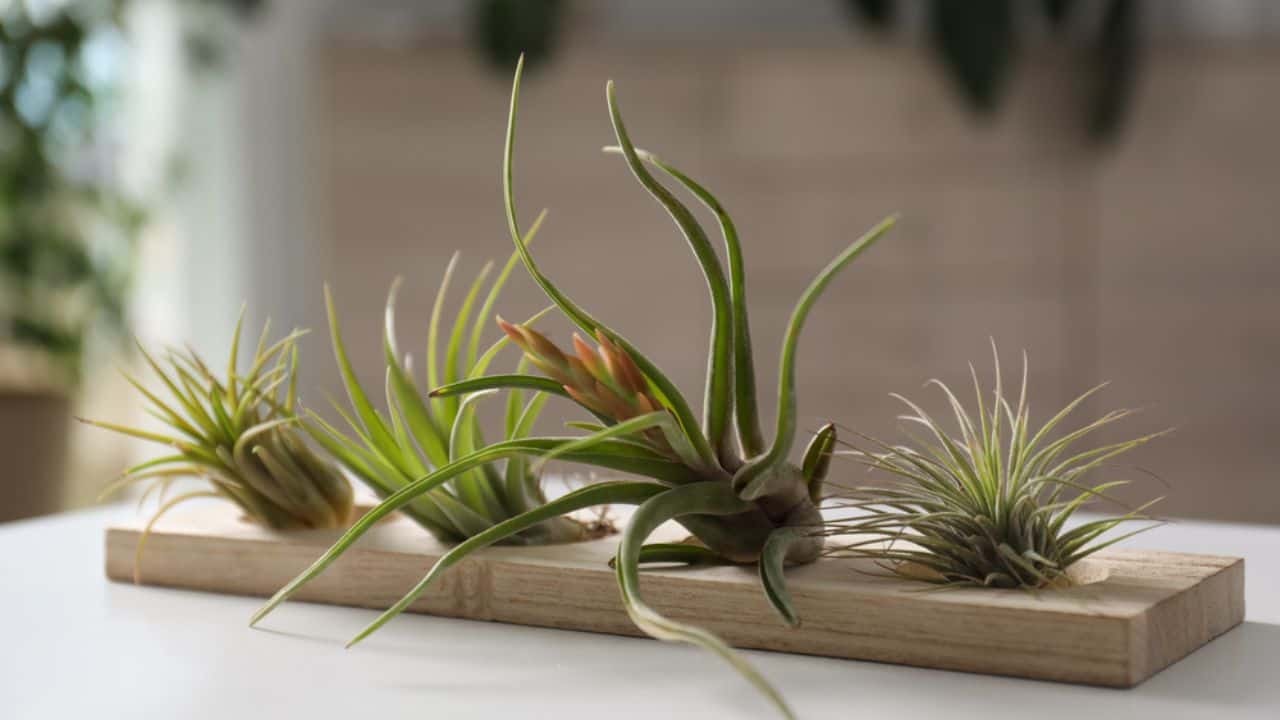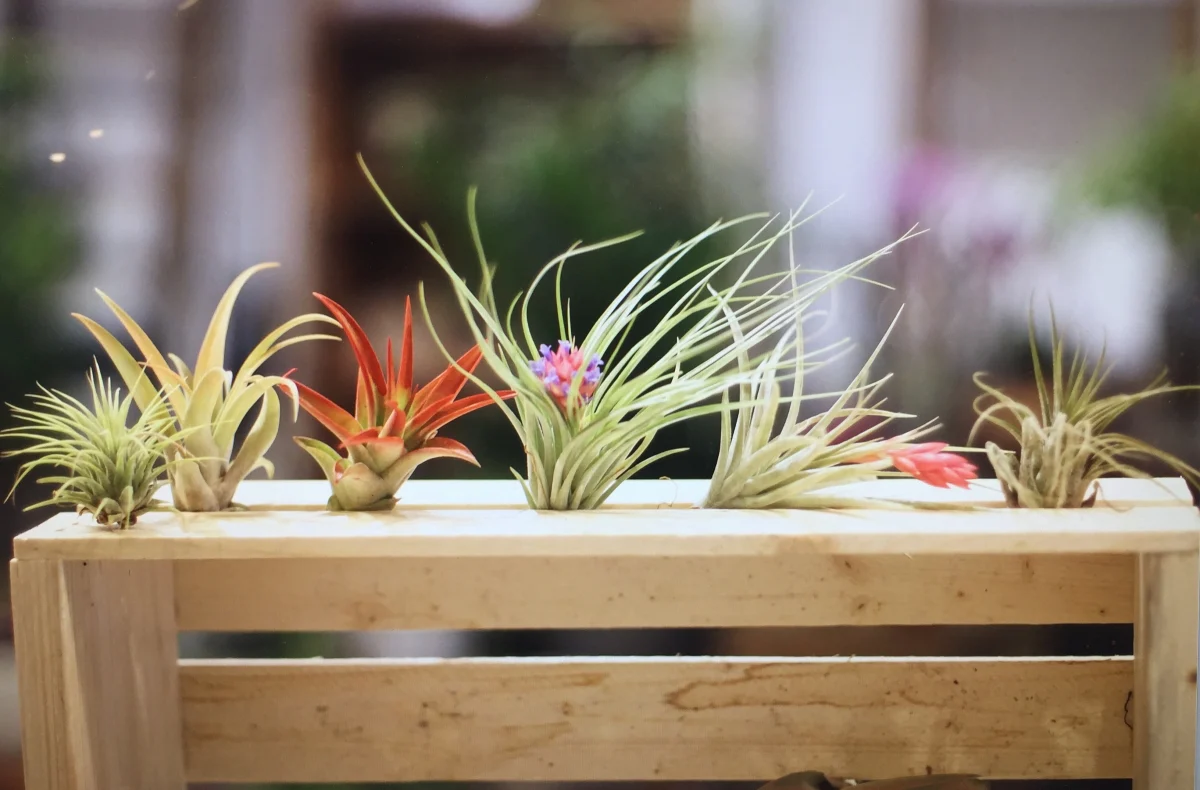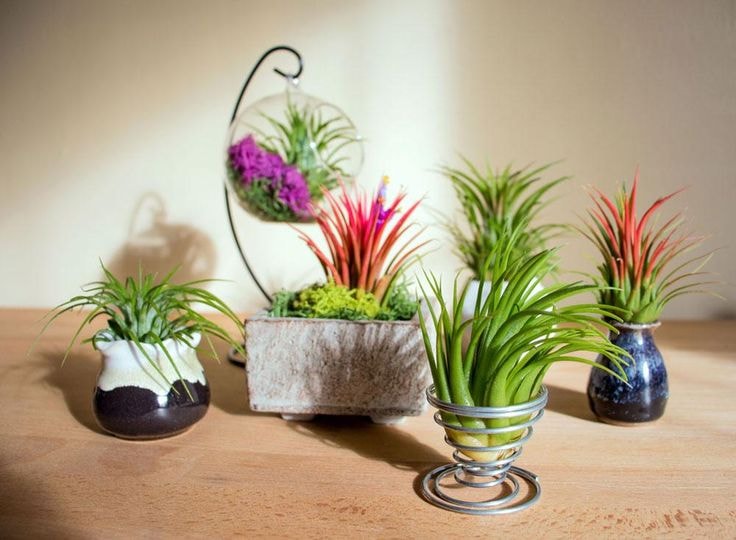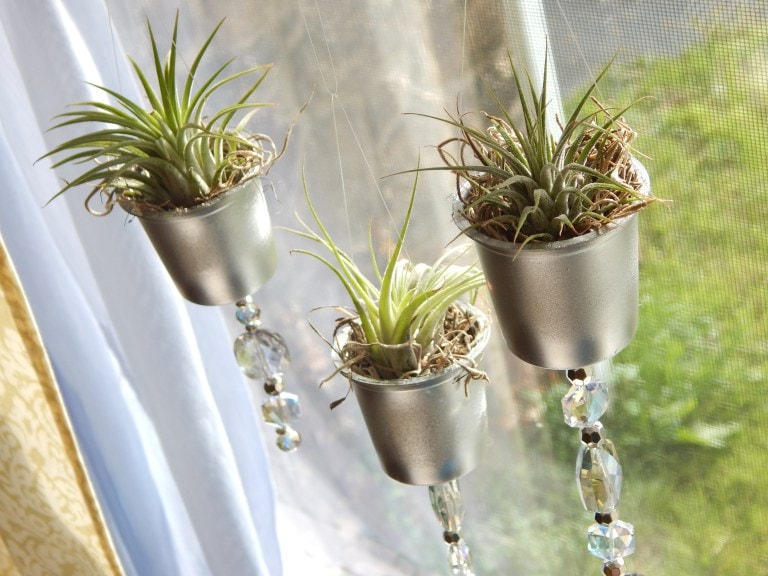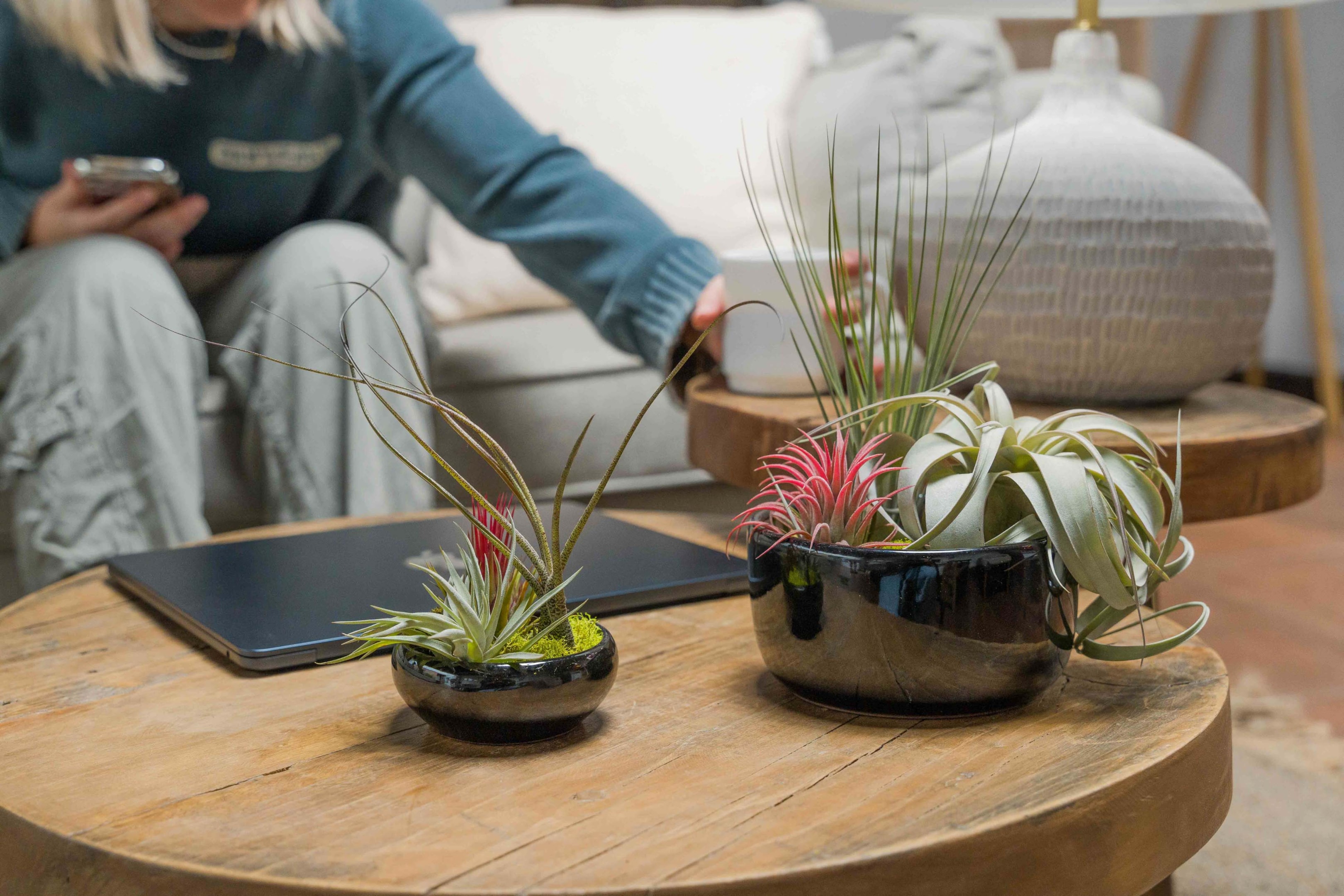HousePlantJoy is supported by our audience. When you purchase through one of our links, we may earn a small affiliate commission. As an Amazon Associate I earn from qualifying purchases. Your cost is not affected.
==================
Air plants, also known as Tillandsia, are captivating marvels of nature that thrive without soil, making them some of the most versatile and low-maintenance plants to incorporate into your home. These unique plants absorb nutrients and moisture directly through their leaves, which means they can be displayed in ways that traditional plants simply can’t. Whether perched in a geometric terrarium, nestled in driftwood, or suspended in mid-air, air plants bring an artistic touch to any space. Their adaptability and charm make them a favorite among plant enthusiasts and interior designers alike.
Caring for air plants is easier than you might think, but their distinct needs require a slightly different approach than other houseplants. From the right watering techniques to optimal lighting conditions, understanding their care ensures they remain healthy and vibrant. In this article, we’ll guide you through the essentials of air plant care and share creative display ideas to help you showcase their beauty in your home. Let’s dive into the fascinating world of air plants and unlock their full potential.
From Forests to Your Home: The Fascinating World of Air Plants
Air plants open up a whole new world of greenery that’s anything but ordinary. These little wonders hang out in tropical and subtropical areas, happily calling places like forests and deserts home.
With their roots nowhere near the ground, these cool plants grab onto rocks, trees, and even the occasional billboard for support.
What makes them so popular? For starters, they’re completely soil-free, meaning no mess or hassle. This makes them ideal for anyone who struggles with traditional plant care. With just a bit of misting and the right light, they thrive effortlessly.
Their striking shapes and unconventional lifestyle bring botanical drama and elegance to any space, turning ordinary decor into something truly special. Simple to care for and visually captivating, these plants effortlessly combine style and practicality.
Key Takeaways
-
Air plants thrive without soil, absorbing nutrients and moisture through their leaves, offering unparalleled display flexibility.
-
They require bright, indirect light, occasional soaking or misting, and good airflow to stay healthy and vibrant.
-
From terrariums to hanging chandeliers, air plants can be showcased in artistic ways to elevate home decor.
-
Purchasing nursery-grown air plants supports ethical practices and protects their natural habitats.
-
With a wide range of shapes, sizes, and colors, air plants allow for endless customization to match any aesthetic.
Understanding the Growth and Survival Mechanisms
Air plants seem almost magical with how they survive and thrive without the usual soil setup. But there’s no hocus pocus here; these plants have some fascinating tricks up their sleeves. Key to this soil-free lifestyle are trichomes, those tiny, silvery hairs you might notice covering their leaves.
Natural Adaptability
These little wonders help the plant soak up water and nutrients straight from the air. Think of them as the plant’s own version of a sponge soaking up everything it needs to live. And the adaptability? It’s incredible.
Ever wonder how a plant could hang out just as comfortably in your home as in a rainforest or desert? That’s the Tillandsia for you. Adapting to various climates, they can thrive on a breezy balcony or a snug corner of your living room as long as the conditions are right.
Low-Maintenance Greenery
While they enjoy a bit of humidity, they aren’t too fussy. A good soak or misting here and there keeps them happy, mimicking the way they’d drink in a rainforest. With all these unique adaptations, air plants really bring the outdoors in—and they do it with style.
Whether you’re looking to add some greenery to your office desk or spruce up your living room, understanding their needs ensures they continue to flourish, adding a touch of nature’s resilience to your decor.
Essential Care Tips
Taking care of air plants is like having an easy-going friend—they don’t demand too much but appreciate a bit of love and attention.
Lighting for Growth
The key to keeping these plants happy starts with lighting. They love bright, indirect light similar to what you’d find under a forest canopy. A sunny windowsill works wonders, but direct, scorching sunlight? Not so much. Think bright but filtered to let them thrive without getting sunburned.
Watering Tips
Now, onto watering. Remember, Tillandsia are all about moderation. A good soak every one to two weeks usually does the trick.
Dunk them in water for about 20 to 30 minutes, shake off excess water, and let them dry upside down to avoid rot. A gentle mist every few days keeps them refreshed, especially if your home is on the dry side.
Humidity and Airflow
Humidity is another factor to take into account. While air plants come from areas with higher moisture, they can adapt. Just don’t forget to keep the airflow going, ensuring they dry off quickly after watering. If you’re in a particularly dry home, a mini-humidifier nearby can imitate their natural environment nicely.
Common Plant Issues
Even the simplest plants can face challenges. Browning tips or shriveled leaves often signal a need for extra moisture, so tweaking your watering schedule or misting more frequently can help. On the other hand, yellowing leaves might indicate overwatering.
Scaling back should set things right. Striking the perfect balance ensures these unique greenery pieces remain vibrant and rewarding without adding stress to your routine.
Keeping Your Air Plants Thriving in Dry Climates: Tips for Proper Hydration
In dry climates, air plants may require more frequent watering, either through soaking or misting 2-3 times per week, to maintain adequate hydration.
Check out this video on how to care for air plants.
By: Succulents Box
Air Plant Varieties: Exploring the Diversity
Air plants cover quite a spectrum with their diverse looks and styles, making them perfect for personalizing your space. Some of the go-to include species like Tillandsia Ionantha and Tillandsia Xerographica.
The Ionantha is a fan favorite, small and often blushing with beautiful hues of green and red, depending on light and conditions. The Xerographica, on the other hand, is a stunner with its wide, curling leaves and larger size, perfect for a bit of show-stopping allure.
Beyond these popular ones, there’s a whole array of aesthetic and size options. Some are petite and almost whimsical, like the Tillandsia ‘Bulbosa’, with its twirling leaves, whereas others, such as the Tillandsia ‘Caput-Medusae’, have a wild, almost mythical air with their serpent-like tendrils.
Selecting the Perfect Plant
These visual variations give you endless ways to mix and match depending on the vibe you’re going for. For those wanting something a bit more exclusive, rare and exotic air plants can be your next adventure. Species like Tillandsia tectorum boast textured leaves that almost look frosty to the touch, providing a unique tactile element to your collection.
Choosing the right air plant variety means considering not just their look, but also where they’ll be living in your space. Some will thrive in lower light, others need the brightness. Match their needs to what you can provide to keep them healthy and vibrant.
Every air plant is a statement piece waiting to happen, all while being easy enough to care for that you can keep adding to your collection without breaking a sweat.
Creative Display Ideas to Showcase Air Plants at Home
Air plants offer endless opportunities for creativity in home decor. Their versatile nature allows you to unleash your artistic side and transform ordinary spaces into lush, green sanctuaries.
Elevated Plant Décor
One popular method for showcasing these unique plants is by placing them in decorative containers or terrariums. Glass globes or geometric designs lend a sleek, modern aesthetic while providing a full view of their intriguing forms. Adding layers of colorful sand or stones can further enhance the visual appeal.
For a more elevated approach, wall displays offer a creative way to integrate greenery into your decor. Crafting living wall art with a mix of plant varieties creates a stunning natural focal point. Wooden frames or metal grids make excellent bases for structured arrangements, highlighting each plant’s distinctive shape and vibrant hues.
Dynamic Hanging Displays
For something with more movement, consider hanging displays. You can craft air plant chandeliers that catch the light beautifully or suspend them from ceiling hooks. Adding in driftwood or macramé gives your hanging air garden a bit more texture and a bohemian vibe.
These display ideas not only make your space more vibrant but also let your personality shine through. With a bit of imagination, air plants can transform any room into a tranquil, aesthetically pleasing environment, inviting nature’s quirky beauty right into your home.
DIY Air Plant Projects: Personalized Decor Creations
Creating your own air plant holders is a fun way to add a personal touch to your space. With just a few supplies, you can design something that’s both unique and functional. Consider using wire wrapping techniques to create custom stands or hanging ornaments.
It’s an easy way to make something that perfectly fits your style and the plant’s needs. Everyday items can be transformed into beautiful air plant displays. Old picture frames, used teacups, or even quirky kitchenware can become homes for your plants.
Look for materials around your home that can be repurposed—it’s both sustainable and gives your air plants a chic spot to thrive. Seasonal arrangements are another great way to incorporate air plants into your decor.
Think about using small pumpkins for fall, or shiny ornaments and glossy ribbons around the holidays. These little changes create a fresh look and allow your displays to evolve with the seasons.
By diving into DIY projects, not only do you get a chance to express creativity, but you also deepen your connection to these fascinating plants. Making small projects as gifts for friends or family spreads the joy of air plants, sharing nature’s charm and your unique flair.
Combining with Other Decor Elements
Think of air plants as the perfect partner for mixing and matching with other decor elements. They look fantastic when paired with natural finds like stones, shells, or driftwood. Their minimal needs make them ideal for creating small zen spaces, bringing in a slice of the natural world with ease.
Green Vibes Integration
If you’re into a lush, green vibe, try integrating air plants into larger plant arrangements. Mixing them with succulents or ferns will add new dimensions in texture and height. Hanging around the edges of a planter, Tillandsia bring a nice contrast to the typically soil-bound plants.
Artful Plant Pairings
For a bold scene, complement your air plants with artwork or sculptures. Arranging them around a statue or mixing them into a gallery wall can make your plants pop in a creative, unexpected way. Their unusual forms draw attention and spark curiosity, making conversations easy and décor lively.
Creative Plant Accents
Blending air plants with these different accents not only boosts their impact but enriches the entire space. It’s about uniting natural beauty with creative expression, crafting a home environment that’s as unique as it is welcoming.
Sustainability and Ethical Considerations in Air Plant Purchasing
When bringing air plants into your space, it’s worth thinking about where and how they’re sourced. Not all air plants come from sustainable practices, and a little research goes a long way in protecting both the environment and the plants themselves.
Choosing Ethical Sources
First off, consider purchasing from reputable vendors who prioritize sustainability. Ethical sellers often emphasize their dedication to preserving ecosystems while providing healthy, vibrant options.
They typically source their selections from nurseries rather than wild habitats, ensuring the protection of natural ecosystems and supporting responsible cultivation practices for future generations.
Understanding the environmental consequences of wild harvesting is essential. Over collecting from natural habitats can deplete populations and disrupt delicate ecological balances, harming local biodiversity. Opting for nursery-grown varieties is a thoughtful way to safeguard these unique plants and their native environments.
Support Local Sustainability
Supporting local growers and nurseries is another smart move. Not only does it ensure that your plants are sustainably sourced, but it often means the plants have been adapted to your local climate, keeping them healthier and more robust.
Incorporating these eco-friendly practices contributes to a more sustainable future, allowing the beauty of air plants to be enjoyed responsibly and ensuring they continue to grace homes without compromising their natural habitats.
Watch this video showcasing 51 of the most amazing air plant display ideas.
By: Balcony Garden Web
Cultivating Air Plants: Enhancing Your Home with Nature’s Adaptability
Air plants are more than just unique, soil-free wonders; they are a testament to nature’s adaptability and resilience. Their striking forms, low-maintenance needs, and endless display possibilities make them a delightful addition to any home. By understanding their care requirements and exploring creative ways to showcase them, you can transform your living space into a vibrant, natural sanctuary. Whether adorning a terrarium, enhancing a hanging display, or blending seamlessly with other decor elements, air plants bring life and charm to any setting.
Beyond their aesthetic appeal, cultivating air plants also fosters a deeper connection to sustainability and mindful living. By choosing ethically sourced plants and supporting local growers, you help preserve their natural habitats and contribute to a greener future. Air plants remind us that even small choices in our homes can have a significant impact, merging beauty, responsibility, and a love for nature into a truly rewarding experience.
Frequently Asked Questions
Can Air Plants Survive in Low-light Environments?
While air plants prefer bright, indirect light, some varieties can tolerate lower light conditions. However, prolonged low-light exposure may hinder their growth and vitality.
Are Air Plants Safe for Pets Like Cats and Dogs?
Most air plants are non-toxic to pets, but it’s always good to keep them out of reach to avoid accidental ingestion or damage to the plants.
What Are Some Unique Ways to Display Air Plants Outdoors?
Outdoor displays can include mounting them on tree branches, incorporating them into garden art, or using driftwood and shells to create a natural aesthetic.
Do Air Plants Flower, and How Can I Encourage Blooms?
Yes, air plants bloom once in their lifetime, usually near the end of their life cycle. Providing ample light, proper watering, and occasional fertilization can encourage flowering.
How Do I Propagate Air Plants to Grow My Collection?
Air plants produce “pups,” or offsets, after flowering. Once the pups are about one-third the size of the parent plant, they can be gently separated and cared for as individual plants.
Join us in Our Community
Unlock Valuable Knowledge: Access essential advice that will help your plants thrive and reach their full potential.
Expert Support: Engage with our experienced team on social media platforms like Facebook and Twitter. Our gardening professionals are ready to assist you on your plant journey.
Connect with Fellow Plant Enthusiasts: Be part of a vibrant community of plant lovers, share your experiences, and grow together. Join us today! Follow Houseplant Joy on Facebook, Instagram, and Twitter for daily inspiration and to elevate your plant experience! #HouseplantJoy #GreenThumbsUnite #HouseplantLove


